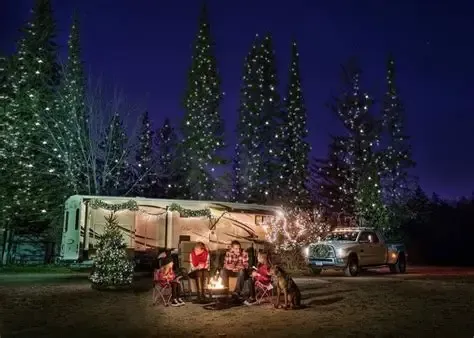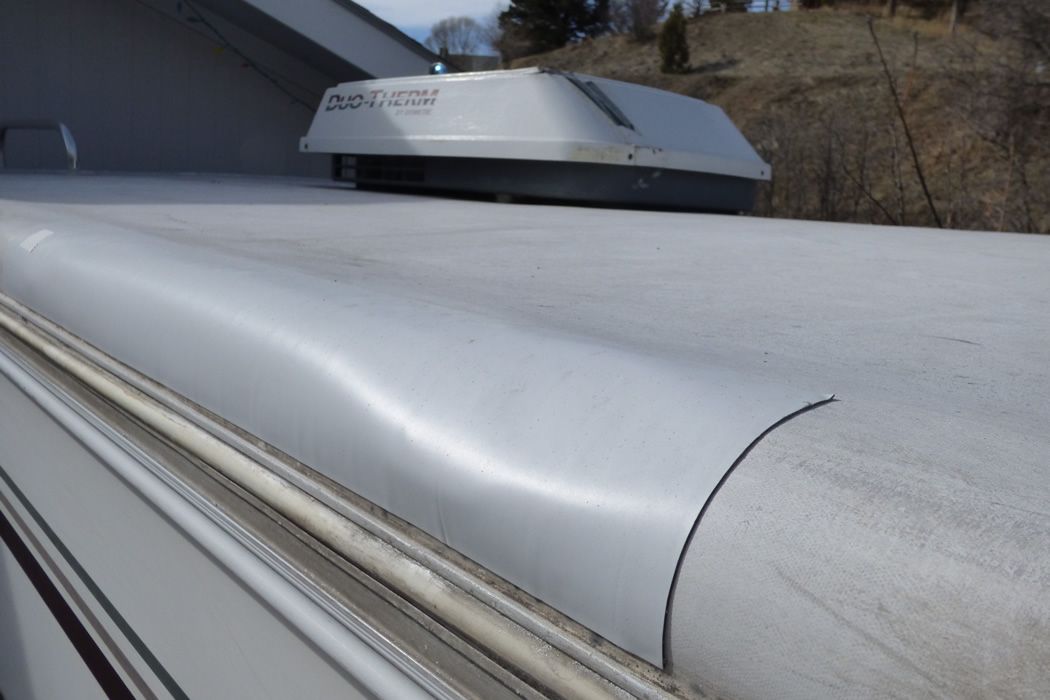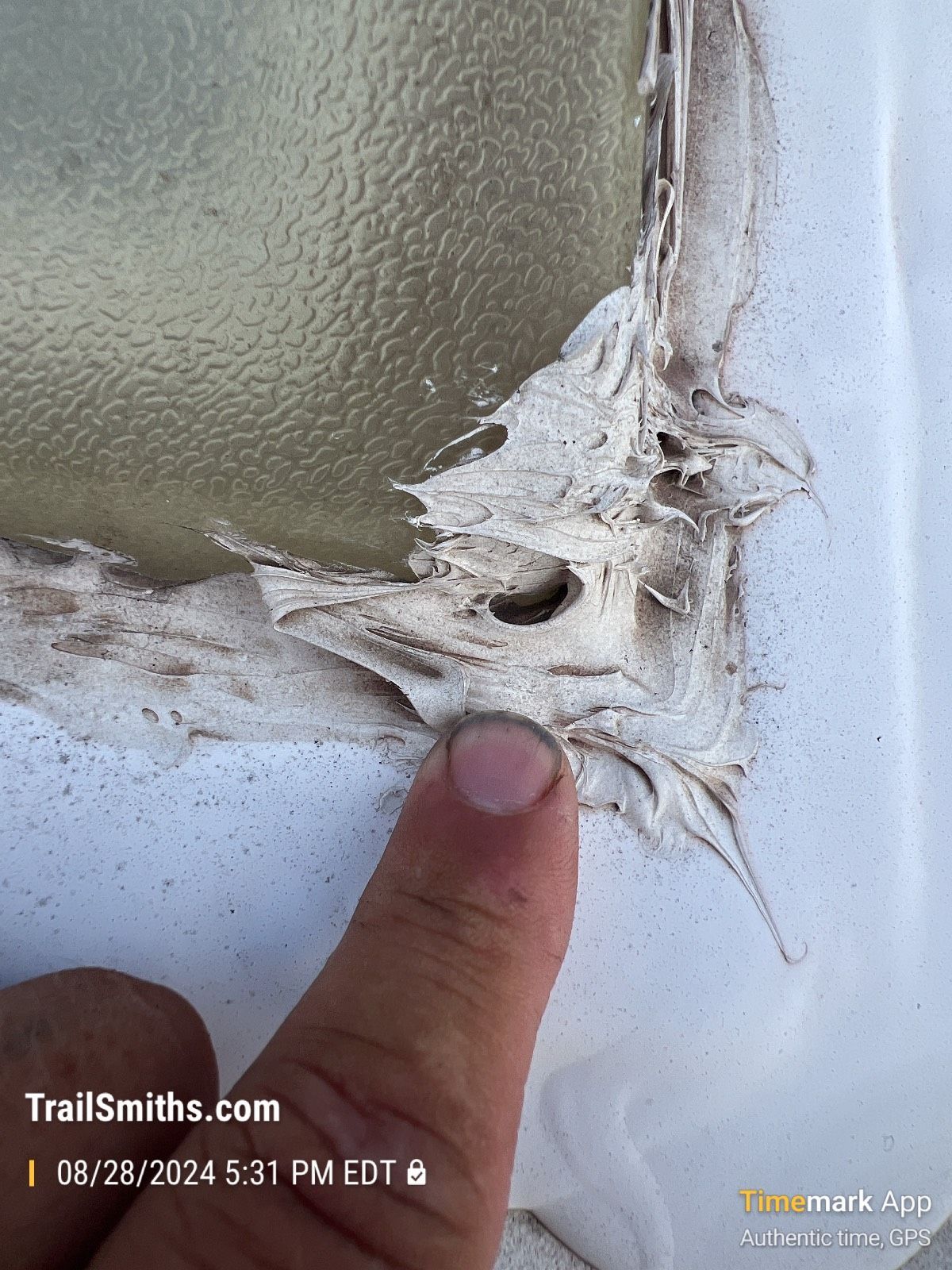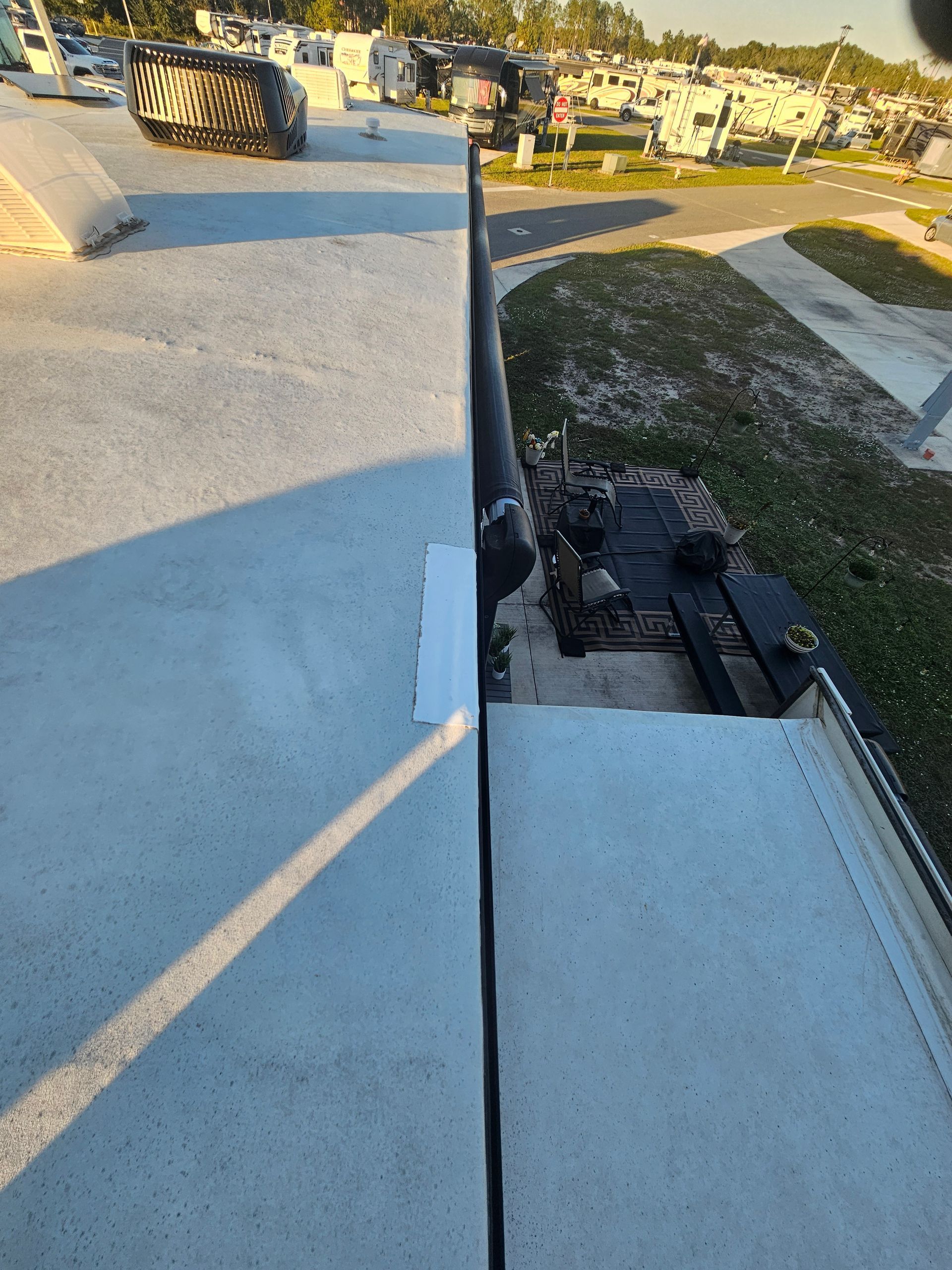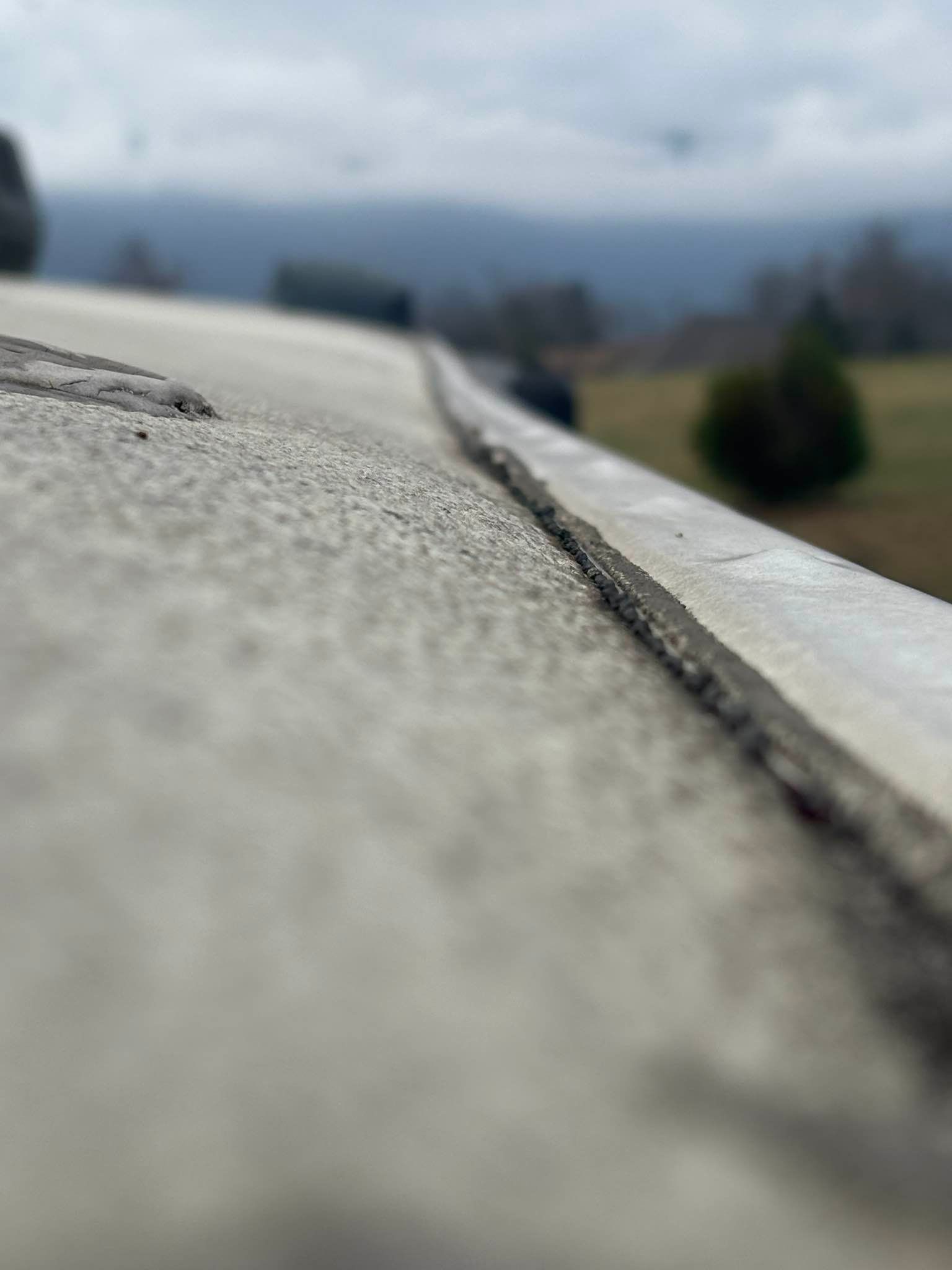Unexpected RV Roof Damage & Navigating the Insurance Claim
Unexpected RV Roof Damage & Navigating the Insurance Claim
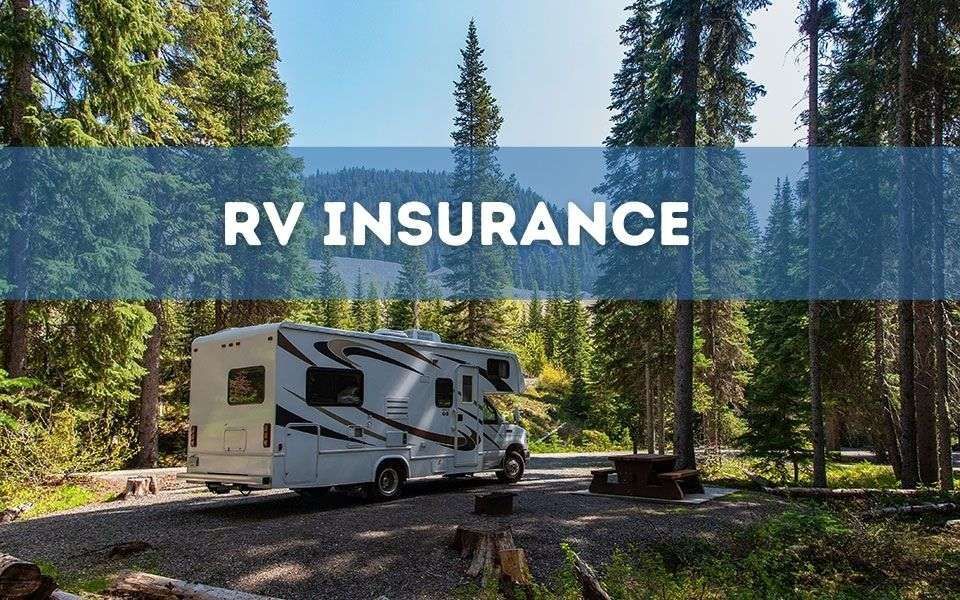

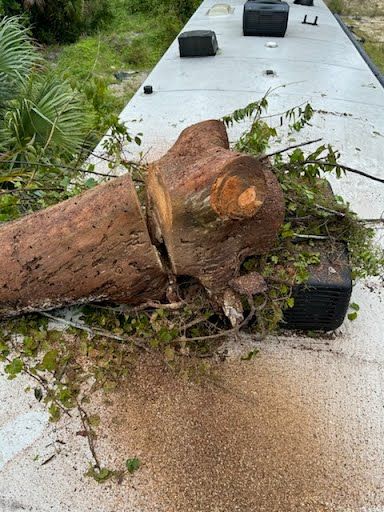
Filing a Claim
- Document the Damage – Take ( a lot) of clear well defined photos and videos of the affected areas.
- Review Your Policy – Check for exclusions, such as wear and tear or improper maintenance.
- Get an inspection or find a company that includes the cost of inspection in the estimate - keep in mind some insurance companies may require proof of regularly scheduled RV roof maintenance
- Negotiate the costs - Insurance companies may initially offer a lower settlement, so working with a trusted repair facility r specialty RV roofing company can help ensure fair compensation
- Make sure the company you choose has the Insurance company information, including the claim number & point of contact so they can follow up, as needed.
Repair VS Replacement
Patching the Roof—Many RV owners opt to patch the roof. However, patches are often a band-aid and don't offer a permanent solution. Often insurance companies are willing to pay to patch up the issue but are reluctant to perform a more permanent solution.
Full Roof Replacement – This can involve removing all attachments, inspecting the wood sheeting, and installing a new membrane or alternative like RV Roofing Solutions Complete System.
Alternative Solutions- There are many RV roofing companies out there patching and repairing rv roofs today. Please do your homework when selecting one. You will want to prioritize experience, quality, customer feedback, and reliability when making your decision. By selecting a reputable and trustworthy repair service, you can ensure that your RV is in good hands and ready for your next adventure.
Getting an Estimate
Take the time to call several companies. Finding a shop can be tricky and often tie up your RV for months at a time.
Get a minimum of 3 different estimates to compare. Often, we recommend getting one from a dealership as well as several other companies. The cheapest one is not always the best option. There are also nationwide mobile RV roofing companies like RV Roofing Solutions that can provide an estimate and work with your insurance company.
Some Questions to Ask:
- How long will it take to complete the repairs/installation?
- What is the lead time for the company?
- How long have you been in business?
- What is the warranty on the service you are being provided with?
- Verify the type of repair - Is it a full system or patch?
- What materials are being used?
- How does the warranty work if you do have an issue after the roof is completed?
Where Can I get my rv roof fixed?
Traditional RV Roof Repairs & Replacements in a shop or rv repair facility can cost substantially more ranging from $5000-$18,000 on average. That's a pretty big price range and it will vary greatly based on the material your roof is made of TPO, EPDM, Vinyl, rubber, aluminum, PVC, metal, or fiberglass. With so many options you can see why the price can vary so much.
In addition labor costs can vary greatly ranging anywhere from $100 an hour to almost $300 per hour in some locations. Material, shipping, product & disposal fees can also add up pretty quickly.
We hear from clients, all the time, who have had their roof repaired at a local shop and have lost the ability to use their RV for up to eight months because it took the shop that long to complete the repairs. RV roof repairs can take a long time at a repair facility due to several factors, including parts availability, technician shortages, open hours, and insurance processing delays - at least that is what the shop may tell you. Skilled RV roof repair specialists are in high demand, which can also lead to longer wait times. This is sometimes true with mobile companies as well. Remember that RV repair businesses get busier in spring and summer, increasing lead times.
Specialty RV Roofing Companies - There are a handful of options when searching for a company that specializes in RV roofing, ranging from shops you have to take your RV to their location & others that have mobile technicians that come to you.
There are a handful of companies that do offer Lifetime warranties. A Lifetime warranty typically covers manufacturing defects and material failures for the lifetime of the product. However, the specifics often depend on the company.
It's totally ok to ask for a copy of the written warranty upfront. Some companies will allow you to see a watermarked copy - others won't. It's also important to note that some warranties cover only defects, while other warranties include only wear and tear. this may mean that the warranty may exclude accidental damage, acts of God, misuse, or unauthorized repairs.
Many RV repair facilities handle general maintenance but may not be specialists in roofing repairs or replacements. Choosing a shop that specializes in RV roofing ensures that the shop or RV roofing company is using proper installation & repair techniques – RV roofs require specific adhesives, membranes, and sealing methods.
The company should have experience with RV roof insurance claims – Specialized companies often know how to navigate insurance coverage for roof damage. RV roofing companies should be using high-quality materials, not settling for the cheapest repair option.
In addition, an industry-trusted shop or company should come with some kind of warranty protection
Choosing an RV repair shop or tech that doesn't specialize in RV roofing you may experience durability Issues – your tech may choose budget-friendly materials that may not withstand harsh weather or long-term wear. A poorly repaired roof can reduce your RV’s market resale value. Some low-cost solutions only provide temporary relief, requiring more repairs later. A short term fix can end up costing more later & insurance may not cover it at that point.
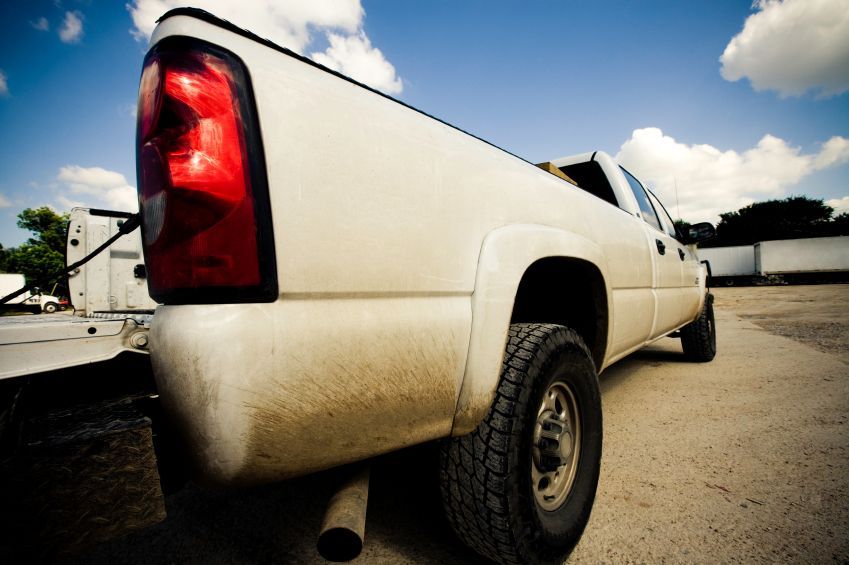
The "taillight guarantee" refers to a warranty or service agreement that lasts only as long as the provider's vehicle is visible—meaning, once the contractor or service provider drives away, the guarantee effectively disappears. Unfortunately we hear about these kinds of warranties all the time from our clients. The term can also be used to describe poor customer service or unreliable workmanship, where a company does not stand behind its product or service after the job is completed. To avoid falling victim to the taillight guarantee it's important to find a reputable company that stands behind their work.
RV Roofing Solutions offers professionally installed maintenance-free roofing systems designed to prevent leaks before they happen, but in the event of an insurance claim they have years of experience in the industry providing both standard repairs and rv roof replacements, including fixing damaged wood or trusses. They are nationwide, mobile & their installers come to you. RV Roofing Solutions offers a maintenence-free roofing system that cures into a seamless, rv roof that no longer needs caulking year after year.
In addition to superior leak protection, their system has built in UV protection & will often keep your rv noticeably cooler. This is because there is enhanced insulation, thickness, and durability compared to traditional RV roofs. Typically, RV Roofing Solutions can cost 30-50% less than a more traditional roof replacement. An added bonus is that every RV Roofing Solutions Complete system is backed by a 10-year material & labor warranty.
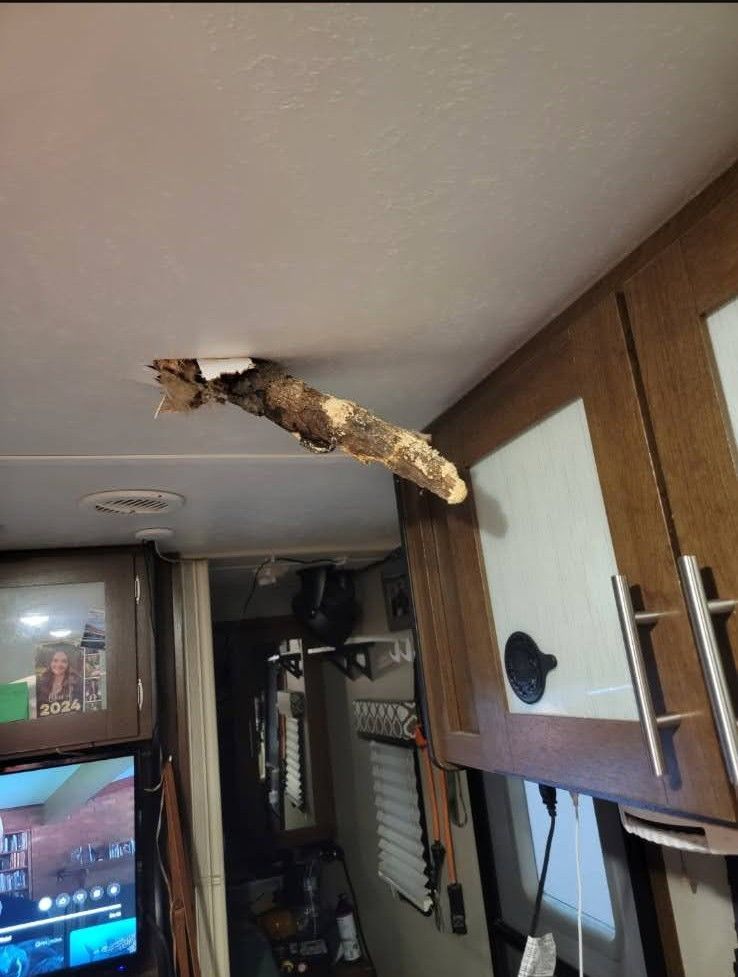
Common Types of Insurance Claims
RV insurance policies typically cover roof repairs if the damage results from sudden and accidental events, such as falling tree branches, hailstorms, or collisions. Comprehensive coverage is the most relevant for weather-related damage, while collision coverage applies if the damage stems from an accident.
Tree Repairs -If a branch falls and punctures the roof, insurance will likely cover repairs.
Hail Damage - This one can be a bit tricky. Often, hail damage isn't seen for months. Hail can cause tiny microfractures in the membrane, not visible to the naked eye, and the damage can show up much later, even with small-sized hail. If you are exposed to hail be sure to document the date and take photos & keep an eye on things. Dents, cracks, or membrane failure caused by hailstorms are usually covered.
Accidents - (impact damage) If the roof is damaged in a collision, it falls under collision coverage.
Storm Damage - Water Intrusion from Storms:
If a storm causes a leak, it may be covered, but insurers often are asked to require proof of regular maintenance
What Might be covered
EPDM Failure -(Ethylene Propylene Diene Monomer) roofing is known for its durability, but it can experience failures over time EPDM has also been known to "fail". Excessive heat can soften the EPDM material, making it feel sticky, especially in direct sunlight. Solvents can also contribute to EPDM failure. If your RV roof feels like fly paper and you are leaving shoe prints in your roof, your roof membrane may be failing. It is the beginning stage of catastrophic failure. *if you have RV roof coverage, this may be covered. Be sure to read your policy.
Membrane Failure as you are driving down the Highway -
RV roof membrane failure while driving can be a serious issue, often caused by poor adhesion, wind lift, or aging materials.
Here’s what happens:
Wind Lift – Air pressure can get under the front cap, causing the membrane to balloon up and eventually tear.
Adhesive Failure – If the roof glue wasn’t applied correctly, the membrane may start peeling away during travel.
Shrinkage & Aging – Over time, EPDM or TPO roofing can shrink, pulling away from edges and seams
Improper Installation – Some roofs are under-glued or over-glued, leading to long-term issues
High-Speed Stress – Driving at highway speeds increases wind resistance, which can worsen existing weak spots.
It's important to note that not all insurance companies will pay for these repairs. In fact, in some cases, it may be considered a manufacturer defect. You can also reach out to your manufacturer if a claim is denied. Sometimes, they will approve a solution with a company that specializes in RV roofing.
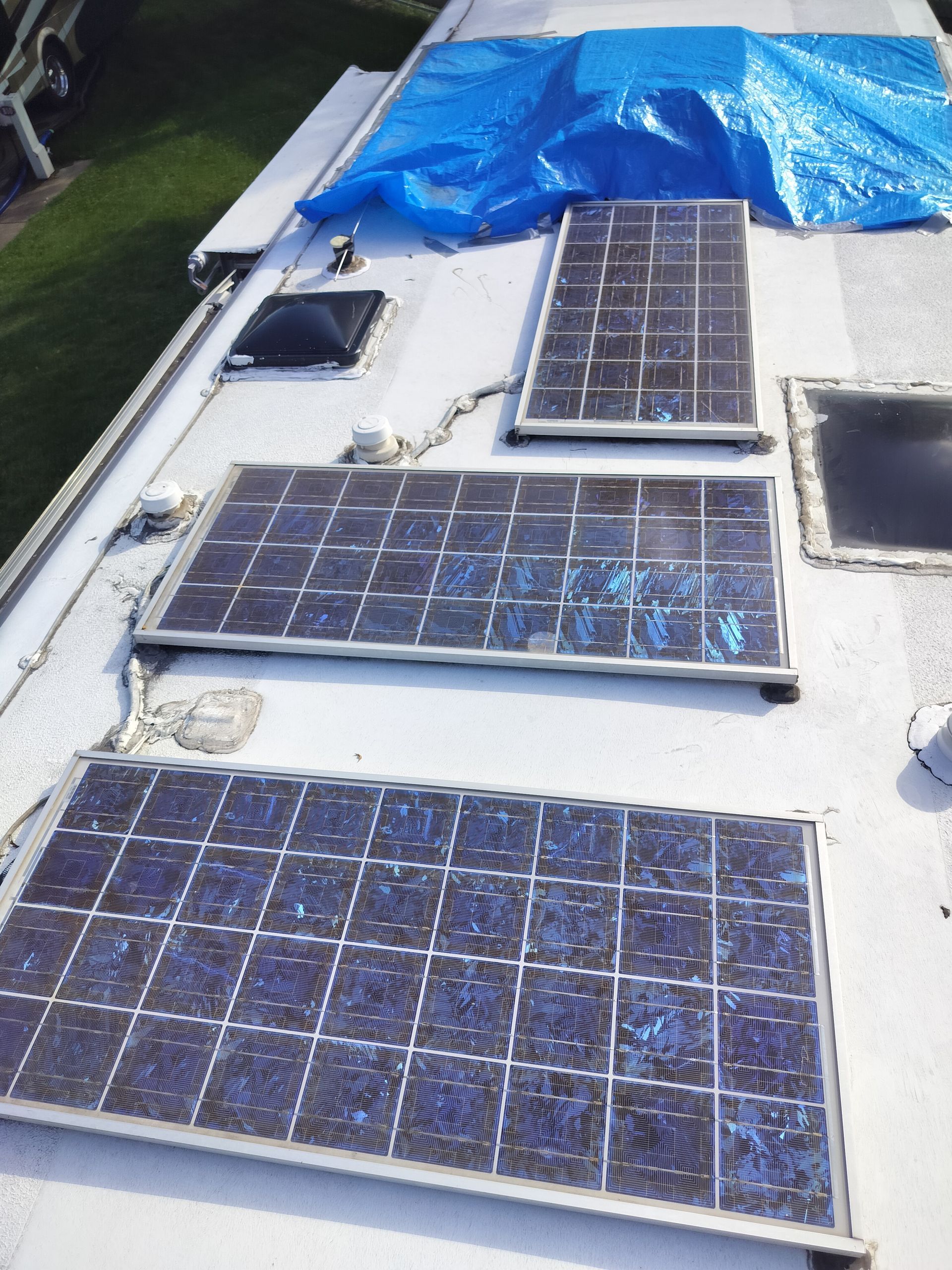
What's not typically covered
Lack of Maintenance-Wear and Tear – Gradual deterioration due to aging or lack of maintenance is typically excluded.
Routine maintenance - It's up to you to remove and replace the sealants on your RV roof every 12-18 months.
Improper Installation – If a faulty repair or installation leads to leaks, insurance may deny the claim
Neglect -If the owner fails to reseal seams or repair cracks, insurers may refuse coverage
Can I patch my roof to prevent further damage?
As an RV owner, you should take a BUNCH of photos before the adjuster arrives and submit those to the insurance company. Take photos and videos of the damage. Make sure if you are providing close up shots you also have pictures from further away to tell the story of the damage.
Once the adjuster comes out and takes pictures, you should absolutely patch the roof in whatever way is necessary to keep it from leaking.
Here are some short-term DIY options
- RV Roof Patch Kits – These kits typically include a flexible membrane and sealant, RV Roof Patch Kit, which is designed for easy application.
- Tape - A strong, UV-resistant tape that can create a waterproof seal. It's widely used for quick repairs and is available in different sizes, such as the EternaBond Tape.
- Liquid Roof Coatings – Some RV owners opt for liquid coatings but if you are patching with a coating of any kind brand matters.
DIY or Professional Installation
This is often one of the big reasons insurance companies don't like to pay for roof repairs or replacement. They want to know that a professionally trained install team is handling the contract & most insurance companies will work hand in hand with that company to verify their credibillity, check their tax ID number andas well as verify their authenticity. Many insurers require a licensed repair company to assess and complete the work.
RV Roofing Solutions actually has an entire blog dedicated to these questions.
When Insurance Might Cover DIY Repairs
- Reimbursement for Materials – Some policies allow you to buy repair materials and submit receipts for partial reimbursement.
- Self-Performed Repairs with Documentation – If you follow proper repair procedures and document the process, some insurers may approve reimbursement. You will need to check with your insurance provider before you attempt this.
Improper Repairs – If a DIY fix fails and causes more damage, insurers will be more likely to deny future claims. We typically have at least a few clients experience this. A few years back, a client got an estimate after a claim and opted to complete the repair himself. ^ months later, the RV was still leaking at the impact point but the roof was even worse. Now, several more sheets of decking needed to be removed and replaced. The insurance company refused to cover any of the repairs and we had to repair his "patch", which ended up costing him a lot more in the long run. It's never fun to experience situations like this.
What not to do
Insurance fraud occurs when individuals or businesses intentionally deceive or overly inflate an estimate to an insurance company to receive unjustified financial benefits. It can take many forms, including false claims, exaggerated damages, or misrepresentation of information.
Always provide accurate information when filing a claim. Knowing what’s covered prevents misunderstandings that could lead to fraudulent claims. Insurance fraud raises premiums for everyone, making coverage more expensive. Staying informed and ethical helps protect both policyholders and insurers.
An honest company will have a written change order or supplemental process already in place when additional issues are found during the repair. Make sure you know the policy for the company you choose for the repairs.
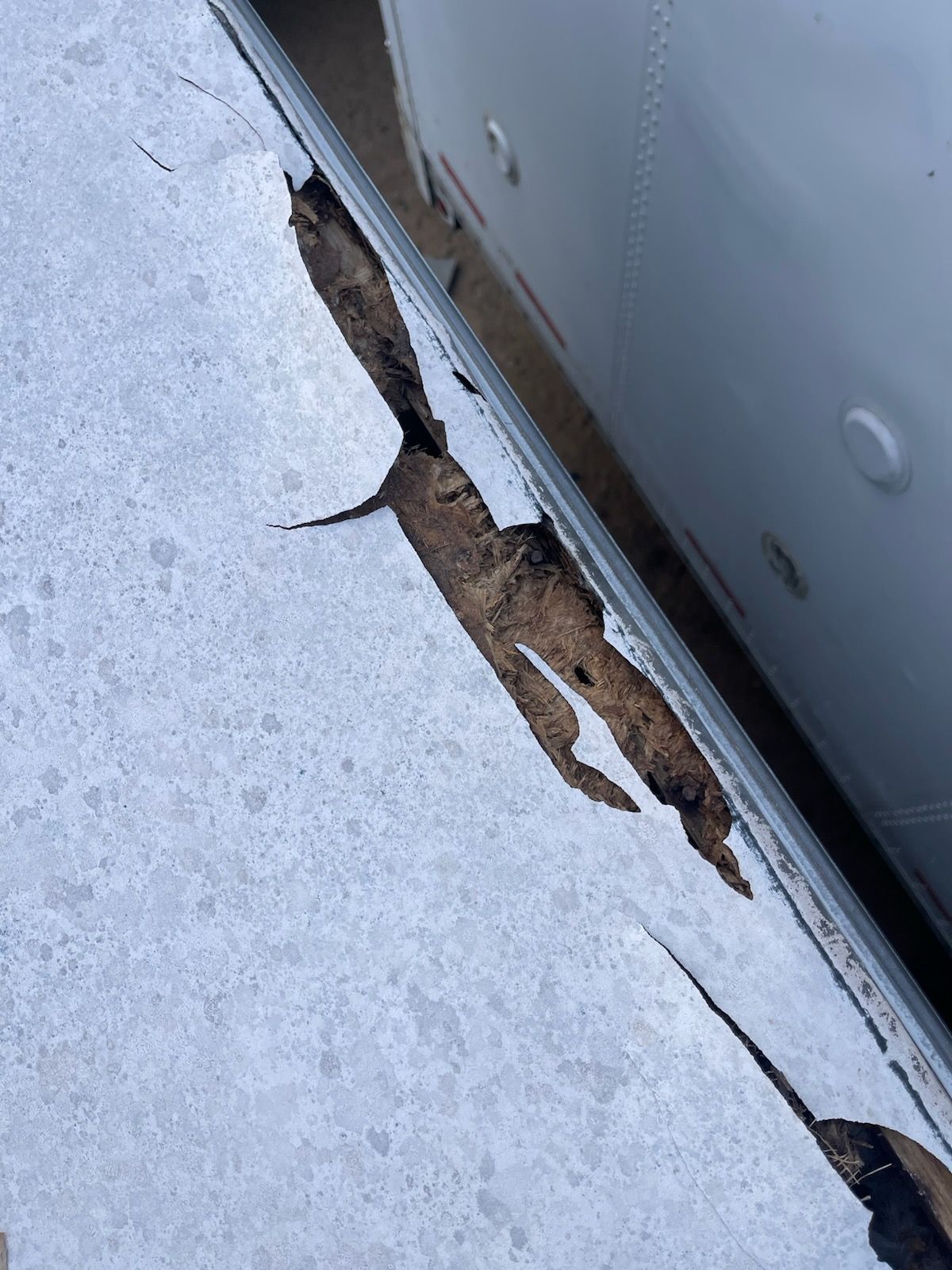
Comparing the Costs
You might be tempted to go with the cheapest option. We would urge you NOT to do this.
Going the cheapest route might save money upfront, but it could lead to bigger issues down the road—literally! A poorly done repair can cause leaks, mold, structural damage, and even lower the resale value of your RV.
Instead of just looking at cost, please consider:
Longevity – A higher-quality repair lasts longer, preventing repeat fixes.
Weather Resistance – Cheap materials may not hold up against sun, rain, or hail.
Insurance Compliance – If the damage happens again, insurers may deny a claim if the previous repair was inadequate.
Navigating RV roof repairs after an insurance claim can feel overwhelming.
Start by reviewing your policy to confirm coverage details and exclusions. Then, be sure to work with a reputable RV repair shop or RV roofing company that understands insurance claims, providing thorough documentation and estimates.
If possible, choose high-quality materials rather than the cheapest option to ensure durability and long-term protection that offers a warranty.
Stay proactive by inspecting your roof regularly and maintaining the instructions given by the company that does the repair or replacement to prevent future issues.
A well-handled claim and repair process will keep your RV road-ready and protected for years to come.

You might also like
RV Roofing Solutions' Blog
